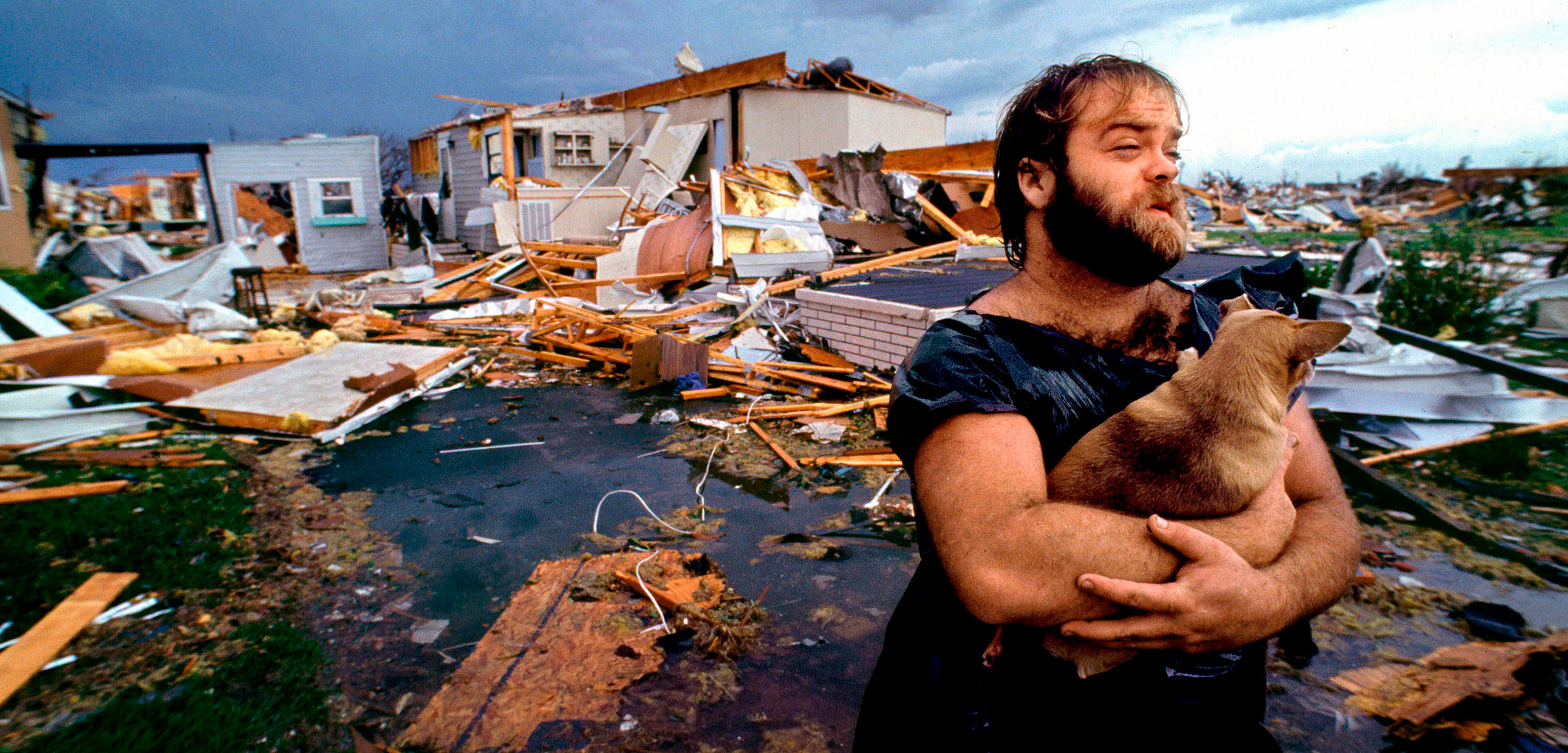In the Face of Mounting Climate Risks, the Insurance Safety Net Is Falling Apart
Natural disasters are costing the US insurance industry a fortune. What happens when no one wants to pick up the tab?
Article body copy
This story was originally published by Grist, in partnership with the Economic Hardship Reporting Project, and is reproduced here as part of the Climate Desk collaboration.
“We’ve got ourselves a little monster out there,” anchorman Jim Cantore warned, facing the camera in the Weather Channel’s newsroom on a sultry August weekend in 1992. At first, few in Florida were paying attention. “It’s very hard to get people to believe that there’s some danger from some element of nature that they haven’t experienced before,” a reporter told Cantore as the channel played footage of tranquil beaches and neat vacation homes.
As the storm approached Florida, it gained the moniker Andrew, rapidly intensifying into a Category 5 hurricane as it exceeded wind speeds of 265 kilometers per hour. Karen Clark, CEO of Karen Clark & Company, which develops catastrophe risk management tools, watched updates on TV from her home in Boston, Massachusetts, with fascinated horror—and her career on the line.
Most insurance companies at that time assessed hurricane exposure in their portfolios by simply multiplying customer premiums by a rough factor of supposed risk rather than tracking actual property replacement costs. “They were just very crude formulas,” she says.
In 1987, Clark started her own company, Applied Insurance Research (AIR), to develop software that better estimated the potential losses from catastrophic events. Unlike the rest of the industry, she used granular data and sophisticated analyses, an approach now called catastrophe modeling. Her first computer model estimated that a Category 5 hurricane hitting Dade County, Florida, could cause losses almost 10 times more than previously believed. She warned her customers about the risk, but until Hurricane Andrew, no one listened. “The good ole boys at Lloyd’s [of London], you know, they thought they had it all figured out,” she says. “They didn’t need any help from this American woman carrying around a little computer.”
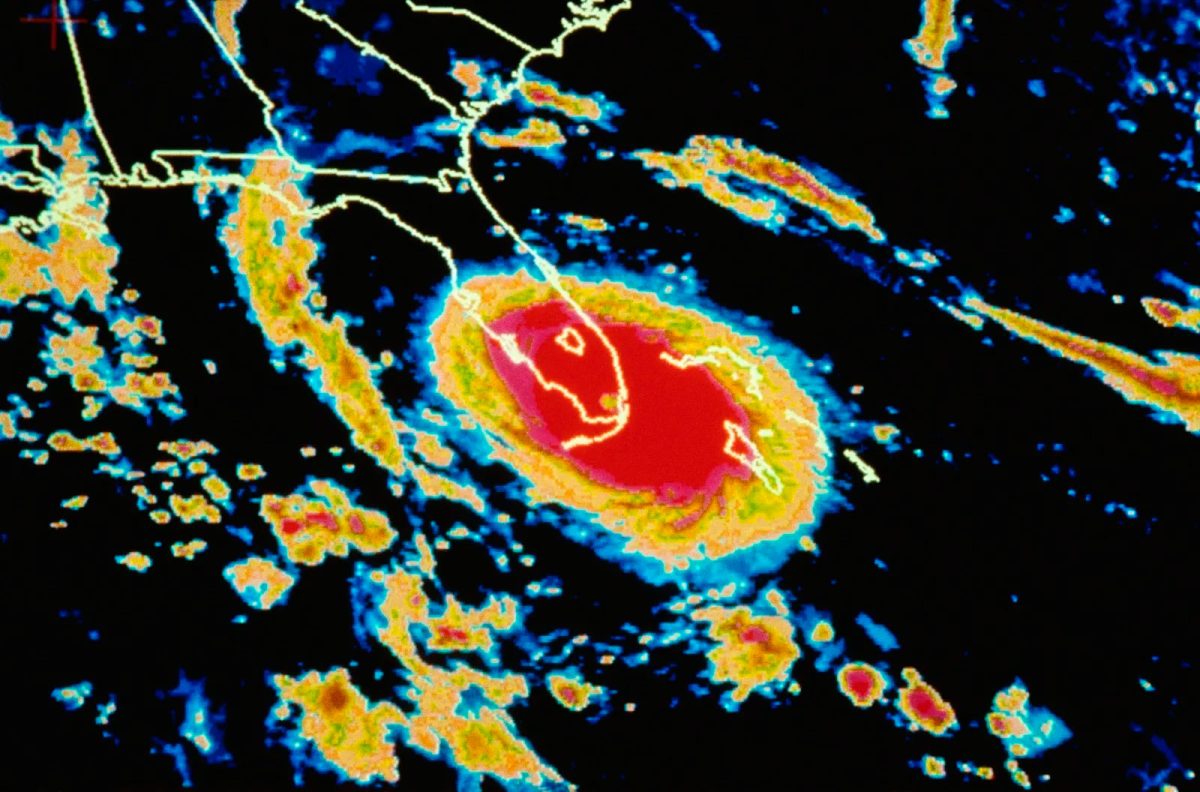
A satellite image shows Hurricane Andrew as it hit southern Florida in August 1992. Photo by Getty/Stocktrek
By that Sunday morning in 1992, it became clear that Hurricane Andrew’s eye was aiming straight for Miami. Clark rushed into the AIR office, where her models suggested that the storm could cause at least US $13-billion in damages—a disaster so expensive that, at first, she debated whether she should publish the results.
As the hurricane made landfall the next day, it tore palm trees from the ground and stripped roofs from houses, carving a devastating path across southern Florida. Over 100,000 homes were damaged, and an additional 50,000 were destroyed. When a client called asking about his probable losses, Clark told him around $200-million. “He said, ‘For the industry?’ and I was like, ‘No. For your company.’” AIR’s estimates turned out to be conservative: Hurricane Andrew eventually cost the insurance industry $15-billion.
In the aftermath, Clark says, “everyone knew the market was going to radically change.” The catastrophe models she developed quickly became the industry standard, changing how US companies navigated risk from natural disasters.
In hindsight, it was the beginning of the dynamic now driving insurance markets. To handle massive payout events like Hurricane Andrew, insurance companies sell policies across different markets—historically, a hurricane wasn’t hitting Florida in the same month a wildfire wiped out a town in California. The companies themselves also pay for insurance—a financial instrument called reinsurance that helps distribute risk across geographic regions. Reinsurance availability remains a major driver of what insurance people can buy—and how much it costs.
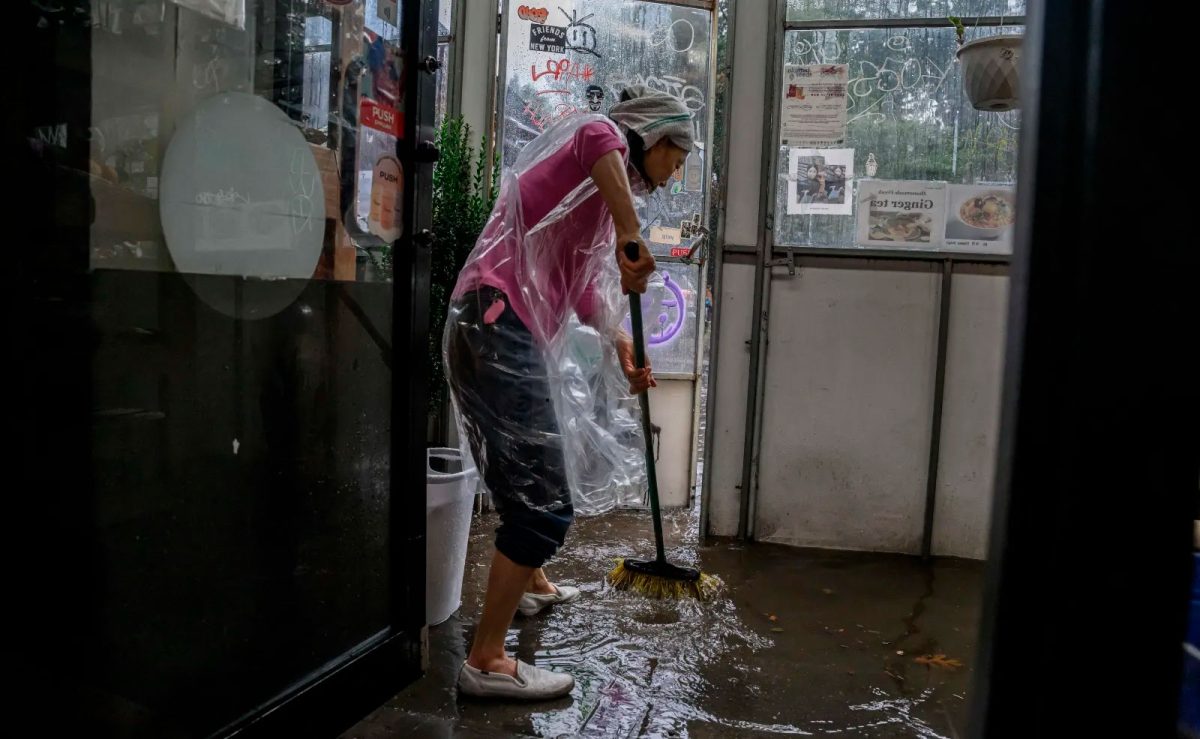
A shopkeeper clears floodwater from her store in Brooklyn, New York, on September 29, 2023, after heavy overnight rains inundated parts of the city. Photo by Ed Jones/AFP/Getty Images via Grist
But as climate change intensifies extreme weather and claims pile up, this system has been thrown into disarray. Insured losses from natural disasters in the United States now routinely approach $100-billion a year compared with $4.6-billion in 2000. As a result, the average homeowner has seen premiums spike 21 percent since 2015. Perhaps unsurprisingly, the states most likely to have disasters—like Texas and Florida—have some of the most expensive insurance rates. That means ever more people are forgoing coverage, leaving them vulnerable and driving prices even higher as the number of people paying premiums and sharing risk shrinks.
This vicious cycle also increases reinsurers’ rates. Reinsurers globally raised prices for property insurers by 37 percent in 2023, contributing to insurance companies pulling back from risky states like California and Florida. “As events are getting bigger and more costly, that has raised the prices of reinsurance in those areas,” says Carolyn Kousky, the associate vice president for economics and policy at the Environmental Defense Fund, who studies insurance. “It’s called the hardening of the market.”
In a worst-case scenario, this all leads to a massive stranded asset problem: premiums get so high that property values plummet, families’ investments dissipate, and banks are stuck holding what’s left. More simply, the global process for handling life’s risks is breaking down, leaving those who can least afford it unprotected.
The idea of distributing risk has been around since the 14th century when insurers of trading ships wanted someone to share the uncertainties of long sea voyages. Modern reinsurance was established in 19th-century Europe, which some historians credit to large fires in Hamburg, Germany, and Glarus, Switzerland, where significant losses led to the founding of many of today’s leading reinsurance companies.
These companies were also some of the first to issue warnings about climate change. Back in 1973, Munich Re, one of the world’s major reinsurance firms, noticed a spike in the number of flood damage claims. In a prescient report, the company noted “the rising temperature of the Earth’s atmosphere” due to the “rise of the CO₂ content of the air, causing a change in the absorption of solar energy.”
Now, the world is reaping the consequences of that change. In the past decade, the frequency of global natural catastrophes jumped by 28 percent. On a single day in July, 60 percent of the US population faced an extreme weather alert. Costs have catapulted, too: since 1970, losses from disasters increased an average of five percent a year, particularly in the United States. That’s because damage also depends on vulnerability and exposure—where people live and how prepared they are. Tragically, the fastest-growing counties also face some of the highest risks. “It doesn’t have to be one of these huge events,” says Alice Hill, a senior fellow at the Council on Foreign Relations who studies climate consequences. “It’s [also] successive events, back to back.”
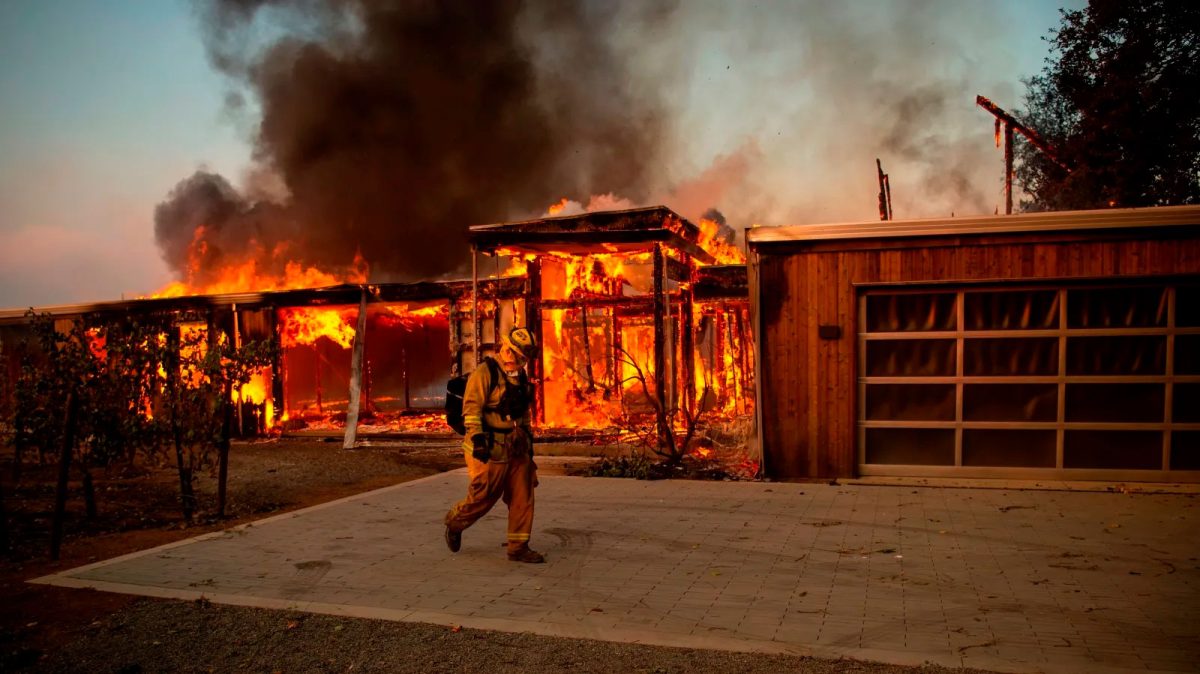
A firefighter walks by a house as it burns during the Kincade Fire in Healdsburg, California, in October 2019. Photo by Josh Edelson/AFP/Getty Images via Grist
Reinsurers are particularly exposed to these hazards because many insurance companies seek primarily to cover catastrophic risks—major events like hurricanes that are intensifying as the world warms. In a letter to shareholders this summer, Christian Mumenthaler, the group CEO of global reinsurance company Swiss Re, wrote that “climate change continues to take its toll … across multiple geographies.”
As a result, the reinsurance industry has paid dearly for much of the past decade; underwriting losses drove $115-billion in global reinsurance losses in 2022. “There’s a tension over a business model that’s retrospective, with a risk that’s emerging,” says Frank Nutter, president of the Reinsurance Association of America. The financial foundation of insurance, in other words, is cracking.
“Without global reinsurance, we wouldn’t have the capacity to provide sufficient disaster coverage for everyone,” Kousky says. “It’s essential.” But unlike insurers, who face political pressures from state regulators to keep rates affordable, reinsurance is much more of a free market. A recent report from Moody’s finds that reinsurers are reacting by raising their rates, limiting their coverage, and even deciding to reduce their exposure in places like Florida. Increasingly, the reinsurance industry is reassessing what are known as “secondary perils,” things like flooding and wildfires—hazards that were previously less costly than major events like hurricanes but which are becoming more common.
Because getting risk wrong is now so costly, there’s been a race in the private sector to model future odds. Jenny Dissen works at the North Carolina Institute for Climate Studies, a research institute that’s part of the National Oceanic and Atmospheric Administration’s Cooperative Institute for Satellite Earth System Studies. She says she frequently fields calls from insurers eager to know the latest climate indicators. Yet critics worry this rush to fine-tune risk predictions may potentially accelerate skyrocketing premiums. Since many are proprietary, the accuracy of these assessments can be difficult to vet. They are also having unintended consequences, like lowering municipal bond ratings, hindering governments’ ability to respond to extreme weather by raising funds.
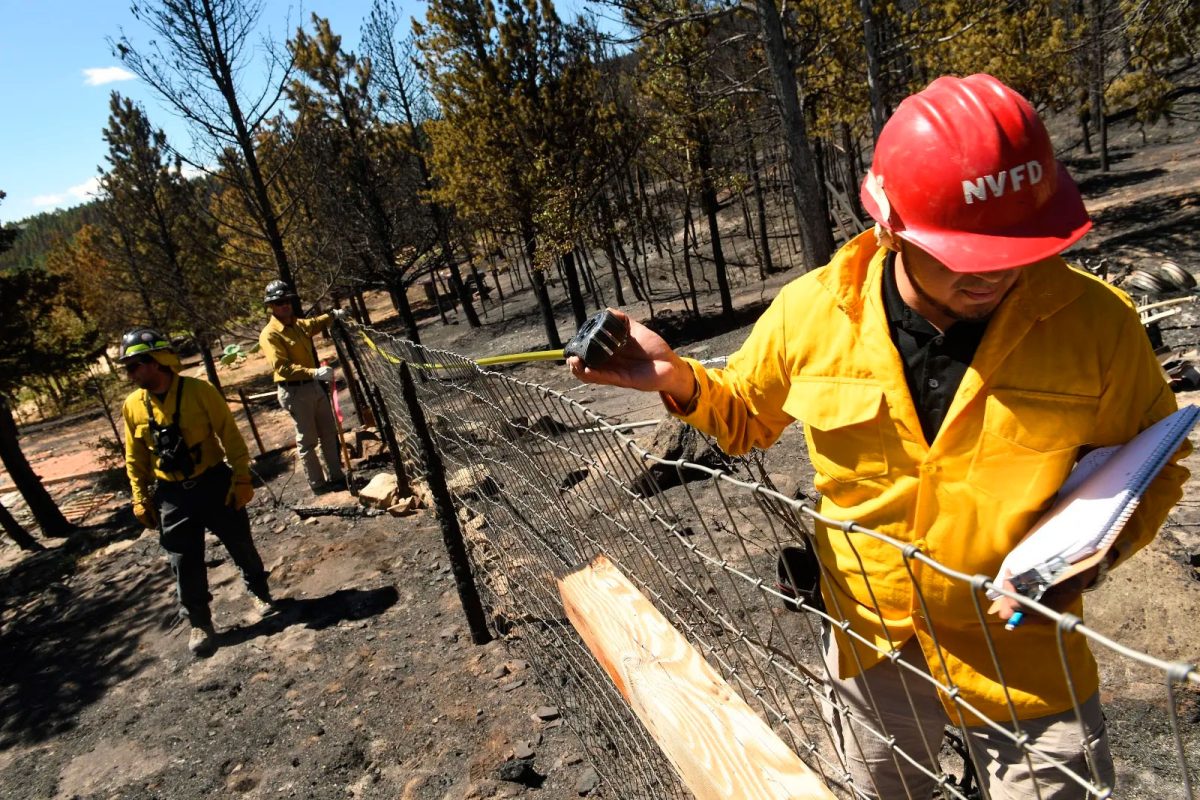
Insurance adjustor Pablo Jimenez tallies property damage in Nederland, Colorado, following a July 2016 wildfire. Photo by Helen H. Richardson/Denver Post/Getty Images via Grist
Some believe that an individual focus is likely not the best—or most equitable—way to address climate adaptation. “Many of these adaptation steps are like a kind of public good” that can’t be taken on an individual level, like building a sea wall, says Madison Condon, a corporate and environmental law professor at Boston University. “They work best if everyone takes them.”
The economic implications of all this are troubling. A new report by the US Department of the Treasury, released at the end of June, found major gaps in the supervision and regulation of insurers. The report advised much closer attention to “the risks the insurance industry may pose to the overall financial sector.”
While insurance prices have soared, a recent report from the nonprofit First Street Foundation estimates that 39 million homes are covered at prices artificially lower than their true risk. The authors suggest that state regulations capping premiums and government-backed insurer-of-last-resort programs have concealed the extent of the crisis. They predict that as disasters continue surging, what they call the “growing climate bubble in the housing market” will pop—leaving millions of homes uninsurable and destroying their value. The average homeowner who loses an insurance policy automatically sees a drop of more than 10 percent in the home’s value, the report notes. “If the value of their home plummets or if the credit agencies downgrade their communities,” Hill says, “one of my big fears is we’re going to have a lot of people trapped in places that are unsafe—economically trapped.”
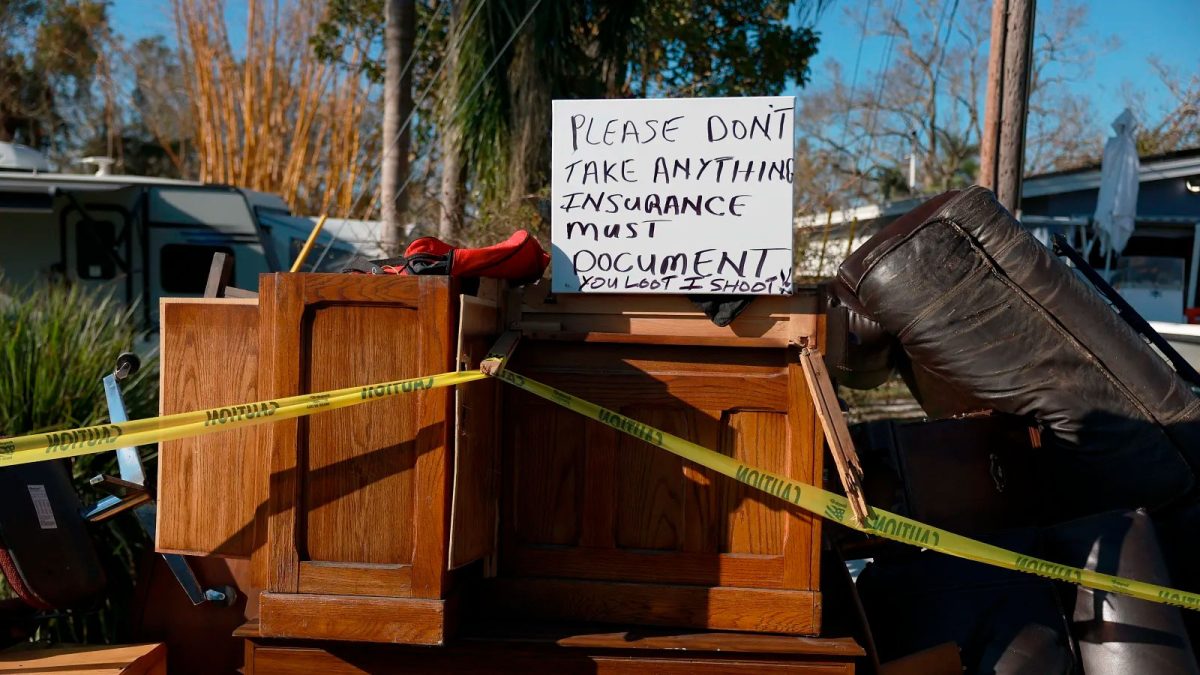
A sign in Fort Myers, Florida, warns passersby to leave damaged home furnishings alone following Hurricane Ian in October 2022. Photo by Joe Raedle/Getty Images via Grist
Such concerns prompted the Treasury Department last year to require 213 large insurers—companies like Allstate and Farmers Insurance—to provide data about their homeowner policies. Its initial goal was to collect information about coverage, claims, and premiums by zip code to identify where climate change may disrupt markets. The plan faced fierce opposition from the industry, which says it’s a regulatory burden and that disclosing this data may harm companies’ competitive advantage. Results are not anticipated in 2023 and will not include other common types of insurance impacted by climate, like flood insurance—which is often covered in a separate policy from homeowners insurance.
This spring, one of the largest insurance brokerage companies warned the US Congress they weren’t moving fast enough. “Just as the US economy was overexposed to mortgage risk in 2008, the economy today is overexposed to climate risk,” Eric Anderson, president of Aon, told US Senate budget committee members. Yet there appears to be little federal urgency in addressing the problem.
Experts warn that increasing prices may tip homeowners toward default as more insurers flee. At least five major companies have stopped writing coverage in some regions. State Farm announced this spring that it would stop selling homeowners’ policies in California. The company cited “rapidly growing catastrophe exposure and a challenging reinsurance market.” Allstate also quietly stopped writing new policies in the Golden State in June. In Louisiana, where at least 20 companies have left in the last two years, the situation has gotten so bad the state passed a $45-million funding bill in 2023 in an effort to woo insurers back.
Though the government has been slow to address these trends, global financial markets are already basing investment decisions on climate risks. Major ratings companies like Moody’s and McKinsey have recently purchased climate data firms. First Street Foundation, for example, provides climate risk information to many banks, major reinsurers, and government agencies—including Fannie Mae and Freddie Mac, which are already using it to screen for mortgages’ climate exposures. Mortgage purchasers like these, after all, are the ones who may soon be left holding the ashes of assets.
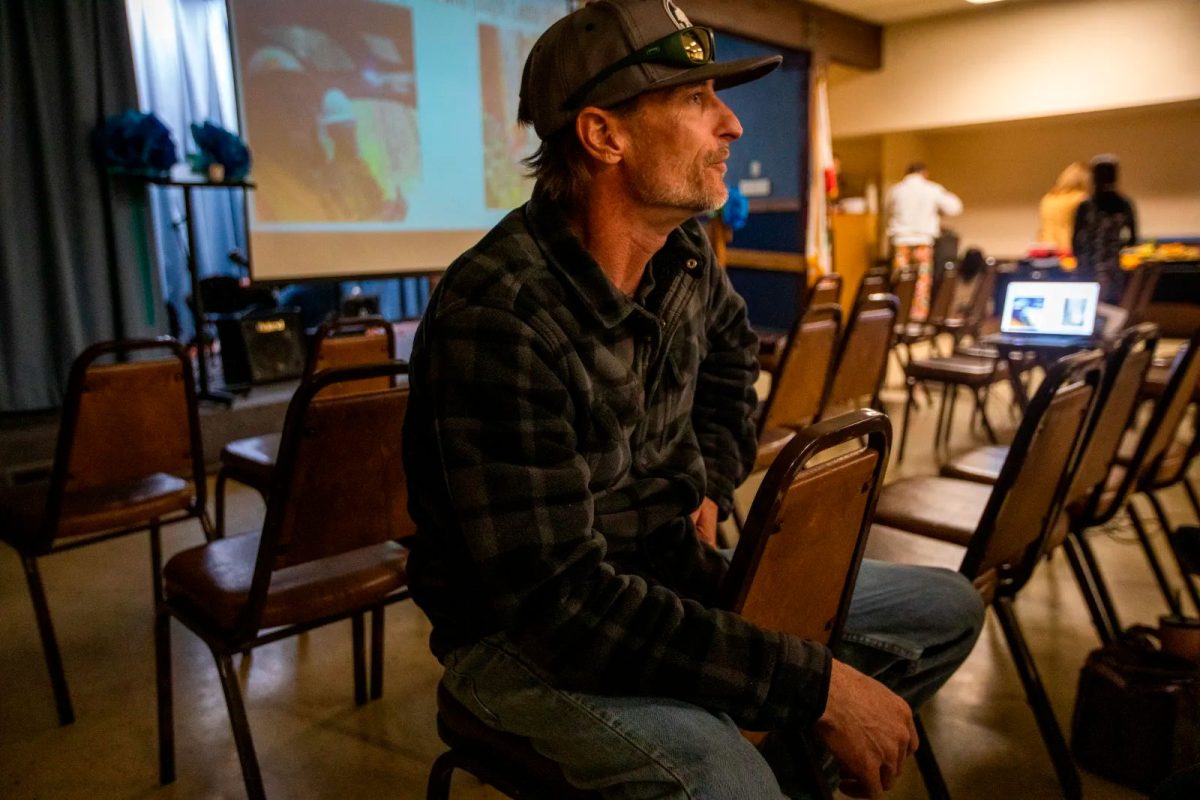
Tobe Magidson of Grizzly Flats, California, sits at a remembrance event to mark the six-month anniversary of the Caldor Fire that destroyed his town. His insurance policy was canceled a year before the fire. Photo by Francine Orr/Los Angeles Times/Getty Images via Grist
Meanwhile, homeowners, many of whose mortgages require insurance, are left with limited options. After six property insurance companies in Florida declared bankruptcy in 2022, for instance, many property owners had to turn to state-run insurers, like Florida’s Citizens Property Insurance Corporation, a government-backed entity serving otherwise uninsurable populations. Although its policies tend to be less comprehensive than private insurance, in the last year its ranks swelled about 50 percent, to around 1.7 million people. Yet this year, as Florida’s reinsurance rates skyrocketed 30 to 50 percent, even these last-resort policy rates spiked 12 percent, leaving many families to weigh whether they can afford to keep their insurance.
If the state is hit by a major hurricane, the program has grown so large that the resulting claims could outstrip Citizens’ budget. The program can’t go out of business like a private company, but if it runs out of money, Florida law allows Citizens to issue one-time bills charging customers up to 45 percent of their annual premium. Someone who just lost their home in a hurricane, in other words, could be facing a surprise bill of thousands of dollars.
Not only is that bad for the families whose losses aren’t protected, it deepens existing inequities. Right now, the insurance market is unintentionally protecting wealthy property owners while socializing their risk through highly subsidized premiums. The US government holds liability for the majority of flood insurance, for example, managed by the Federal Emergency Management Agency. Repeatedly flooded properties make up just one percent of the program’s policies but account for more than 30 percent of the claims. “When the government’s the backup insurer, the taxpayers have to support that,” Hill says.
Two out of every three American homes are now underinsured, meaning owners may face major financial losses if they were to endure a disaster. The effects won’t be felt equally. There can be an inherent tension between climate-related financial risks and anti-redlining efforts: people of color who have long suffered discrimination are now disproportionately living in areas in greater danger of disaster. That makes it difficult to both price climate risks and not divest from underserved communities.
Despite being one of the first to understand these perils, insurers continue to contribute to them. They’ve played a major role in emissions for decades: without insurance, fossil fuel companies have difficulty obtaining financing. Coal is an apt example of what happens when insurers withdraw from a market—since 45 insurers are phasing out of coal policies, construction of new coal-fired power declined by 84 percent between 2015 and 2018.
But insurers have been slower to move away from oil and gas, in part because it’s a larger portion of many companies’ business. In June, the US Senate Committee On the Budget sent letters to major insurance companies asking for information about how much each company earns from the fossil fuel industry. “It is difficult to understand how the industry can carefully price and manage climate risk in some areas of its business,” committee members wrote, “while simultaneously having no apparent plan to phase out its underwriting of and investment in the projects and companies generating the emissions that are causing these very harms.”
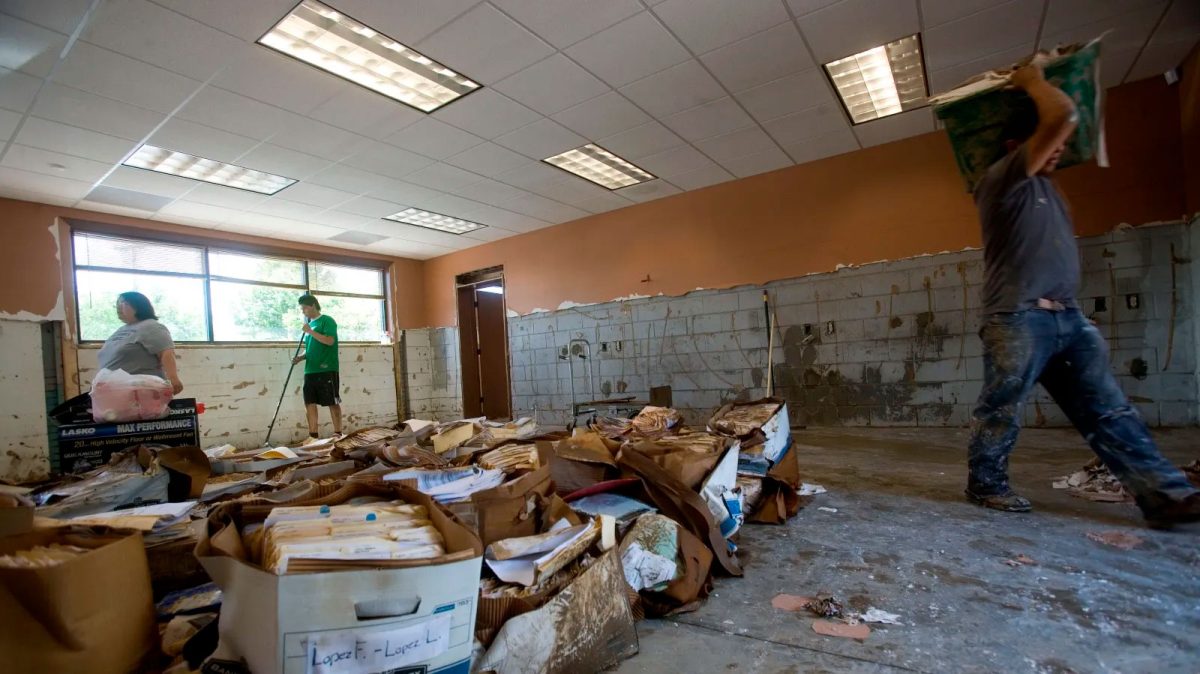
Workers clear debris and attempt to save client records at an insurance office in south Nashville, Tennessee, in 2010 after 330 millimeters of rain fell over two days and inundated whole neighborhoods. Photo by Rusty Russell/Getty Images via Grist
Prompted, in part, by concerns over this kind of liability, the reinsurance industry has begun warning about the need to reduce climate risk. “The economic and insured losses over time are a clear indicator that the past is not a representation of the future,” says Raghuveer Vinukollu, head of climate insights at Munich Re US. Physical mitigation, like building flood walls and buffer zones will be needed, he says, but funding and building these engineering measures can be difficult.
With insurers themselves running out of insurance options, the stability of financial systems is far shakier than many realize. Yet the US government hasn’t developed a national adaptation plan that comprehensively addresses these concerns. In its absence, decisions are left to municipal and state governments, some of which are facing serious blowback. When Hawai‘i recently attempted to increase setbacks for future oceanfront construction, for example, citing immediate sea level rise, homeowners managed to stall the plan. Experts like Condon call for a centralized national climate service that can help guide these adaptations and regulatory policies based on transparent and specific risk assessments.
“If you want to know the truth, the science is the easy part,” Karen Clark says. Getting people to change their behavior, on the other hand, is difficult. She is still working on catastrophic modeling, now at her eponymous firm, where she urges decision-makers to get more realistic, and quickly. “People don’t understand a basic economic law—there’s no free lunch. There’s a risk,” she says. “Somebody’s paying for it. It’s just a question of who.”

